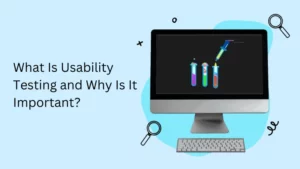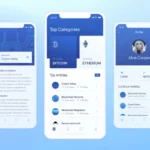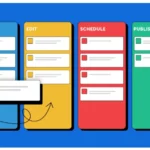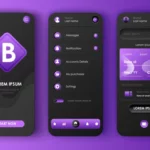Usability testing can be an excellent way for UX designers and architects to create an easy-to-use digital product. Their tests help them make better design decisions, catch gaps or mistakes, and make significant improvements before a product goes live.
Understanding that there isn’t a one-size-fits-all usability test for all projects is essential. There are many different methods. The best choice will depend on your digital product, team, and objectives. Generally, there are two distinct groups to choose from:
- Moderated Vs. Unmoderated Usability Testing
- Remote Vs. In-Person Usability Testing
You can combine a choice from group 1 with a selection from group 2 to develop your approach. Then, you can employ a specific usability test.
Follow along to learn the four most common usability testing methods, their advantages, and their disadvantages. The next section will explore specific usability tests under these umbrellas.
Table of Contents
Moderated Usability Testing
A moderated usability test employs a facilitator (moderator) who leads the user through a trial or a series of tests. The moderator guides the user, answers any questions, and takes notes of the user’s inquiries, comments, actions, successes, and errors.
Pros
- Users may need help navigating and using if the digital product is complicated or centered in a complex industry. A moderated test allows the user to ask questions and immediately receive an answer. Accordingly, they can complete the test and highlight problems.
- Some components may not be usable when a digital product is in the prototype stage. A facilitator can direct the user to the functional parts and gather helpful information.
- Since users can clarify tasks, functions, and features, they are more likely to complete the test to the best of their ability. Accordingly, test results are more accurate.
- Moderators can record subtle behaviors, comments, or questions. They can also follow up on user responses, gathering deeper insights and unique feedback.
- They can be performed remotely or in person, providing flexibility.
Cons
- Many people, real uses included, act differently when they know someone is watching them. They may make mistakes under pressure, take longer to answer questions, make specific remarks, or give particular opinions. The behavior may be unconscious or conscious.
- Moderators can introduce bias to the test. It may be as evident through leading questions or in more subtle forms such as tone of voice, cadence, or facial expressions.
- Whether firms choose remote or in-person usability tests, it demands more resources than unmoderated tests.
Unmoderated Usability Testing
An unmoderated usability test allows users to complete a test in their own environment. Actions and times may be recorded; however, no live moderator or observer is present.
Pros
- Unmoderated usability testing is an excellent choice for specific project functions or digital products almost ready to go live (with complete usability rather than significant gaps). Since there is no guide, it is important that users can self-maneuver and navigate.
- In comparison to moderated usability tests, unmoderated tests require fewer resources. Accordingly, they are cheaper.
- They are quick to run; users do not have to schedule a specific time or place to participate. They can complete the test from the comfort of their own home or office.
- It can be performed remotely or in person, but teams typically favor remote.
Cons
- UX designers and architects must complete basic usability tests before testing, since users must be able to navigate and use the digital product by themselves. Likewise, UX researchers must present questions and tasks as clearly, and simply as possible. If users experience confusion, they cannot complete the test.
- They should not be run with low-fidelity workups, as they are too complicated or confusing for real users.
- Since users can run the test in their environment, their context should be considered when interpreting the test results. Chaotic settings, noise, distractions, and other elements can skew the data.
Remote Usability Testing
A remote usability test offers a particular group of users the opportunity to test a digital product over the internet. Users can complete the usability test comfortably with their own devices. As such, teams receive valuable feedback about how their digital product would be used in the real world.
Pros
- Remote usability testing is cheaper than in-person testing. Firms can take advantage of specific pay-for-use platforms to run their tests.
- Since it is not location-dependent, remote tests can target users across the globe.
- User groups can be larger than in-person groups. In the same vein, it is more likely you will receive a more significant number of participants since it is easier to access the test.
- These tests can run anytime rather than between specific workday hours. Firms can test in the evenings or nighttime if it is ideal for their users.
- Test results are compiled, grouped, and analyzed automatically. The feature saves time and resources and prevents bias in the test results.
Cons
- Since usability tests run over the internet, users can suffer connection issues or device problems.
- Users may agree to take remote, unmoderated tests simply for an offered incentive. They may not take the test seriously, provide accurate responses, or focus on the tasks.
- Due to budget, remote tests may present security issues. Firms may be concerned with their intellectual property, and users may worry about their sensitive, personal information.
- Researchers can only observe a user’s behavior if there is audio or video recording.
In-Person Usability Testing
An in-person usability test, also known as an in-lab usability test, requires users to visit a physical location to test the digital product. They can use special, designated equipment with a stable connection to complete the test.
Pros
- Teams can rely on the equipment, devices, internet connection, and cloud to remain stable for the user, record data, and stay secure.
- While in-person tests can be moderated or unmoderated, the person is typically recorded so that researchers can look at their behavior, verbal commentary, body language, gestures, and facial expressions. These additional observations can be valuable feedback.
- Some types of digital products and user testing should only be performed in person. For instance, eye tracking, facial recognition, or physical movement tracking.
- Tests are performed in a specific time frame at a particular time. Accordingly, context and time are constants in the trial.
Cons
- In-person testing is the most expensive usability testing method.
- Finding users without a worthwhile incentive is difficult, as they must show up at a specific place to perform the test. Depending on the target user group, this could increase costs significantly.
- If users are international or global, it can be challenging to set up in-person tests in every location.
- Users may be less comfortable in an in-lab environment, understanding their every movement is under observation.











